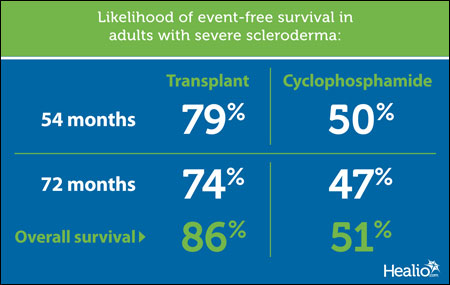Stem Cell Transplant Improves Overall, Event-free Survival in Scleroderma

Myeloablative autologous stem cell transplantation improved long-term clinical outcomes, including overall survival and event-free survival, among patients with diffuse cutaneous systemic sclerosis, according to findings published in the New England Journal of Medicine.
“Scleroderma with internal organ involvement is a devastating autoimmune disorder with considerable morbidity and high mortality which have not changed in 40 years of reporting,” Keith M. Sullivan, MD, of Duke University Medical Center, told Healio Rheumatology. “Effective new therapies are needed.”
According to Sullivan, two previous trials demonstrated benefit for a reduced-intensity stem cell transplant compared with cyclophosphamide, the conventional immune suppression method. However, there were concerns about patient safety and durability of response.

“This was the first study to test if myeloablative autologous could re-establish a normal functioning immune system in patients with scleroderma,” Sullivan said.
The researchers recruited adults with severe scleroderma and randomly assigned them into two groups — 36 patients were assigned to myeloablative autologous transplant, which included high-dose chemotherapy and whole-body irradiation, while 39 were assigned to the cyclophosphamide group. The primary endpoint was a score comparing patients based on disease characteristics at 54 months, including death, event-free survival, forced vital capacity and outcomes as determined by the Health Assessment Questionnaire-Disability Index and the modified Rodnan skin score.
According to the researchers, 67% of 1,404 pairwise comparisons favored transplants as a therapy, compared with cyclophosphamide, at 54 months. In addition, among patients who received a transplant, the likelihood of event-free survival at 54 months was 79%, vs. 50% with cyclophosphamide (P = .02). At 72 months, event-free survival was 74% with transplant, compared with 47% with cyclophosphamide. During the same time period, overall survival was 86% with transplant, compared with 51% with cyclophosphamide.
At 54 months, 9% of transplant recipients began treatment with disease-modifying antirheumatic drugs, compared with 44% of those who received cyclophosphamide (P = .001).
Among the transplant recipients, treatment-related mortality was 3%, compared with 0% among those who received cyclophosphamide.
According to Sullivan, patients with scleroderma should be referred by their primary physicians for a consultation at stem cell transplant centers, to weigh the potential benefits and risks related to stem cell treatment.

“In severe scleroderma, survival and other clinical benefits of transplant were superior to conventional care and these benefits appeared long-lasting,” Sullivan said. “This approach represents a new standard for effective care of this devastating disease.” – by Jason Laday
Disclosure: The researchers report funding from the National Institute of Allergy and Infectious Diseases.
